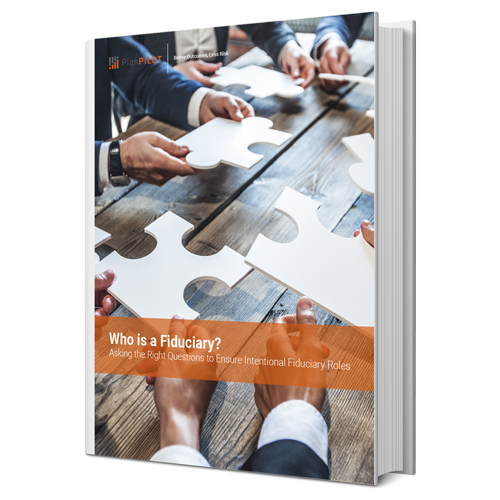Managing a thoughtful retirement plan while trying to keep up with the ever-changing legal and regulatory environment can be challenging. Often, concerns over managing a retirement plan can vary, and plan sponsors are unsure of what needs to be addressed. Below, we review five ongoing plan sponsor concerns that sponsors should keep in mind to guarantee they have an effective retirement plan in place not only to ensure the retirement readiness of their employees, but to avoid liability should an audit occur.
#1 Assessing Fees
There is a growth in lawsuits over alleged excessive fees, so assessing fees have become one of the top plan sponsor concerns. It is critical for sponsors to be cognizant of investment, recordkeeping, and administrative costs. Plan sponsors, and other plan fiduciaries, should focus on evaluating the fees and charges associated with a specific investment, brokerage or other third-party providers.
As stated by the DOL, plan fiduciaries are charged with “paying only reasonable plan expenses.” Due to the fee disclosure regulation, plan providers and investment firms are becoming more transparent with their fees. However, many plan sponsors do not review these disclosures and often do not know what fees are being charged against their plan and plan participants. In your Investment Policy Statement, it is crucial to document the fee structure and monitoring procedures, thus plan sponsors should always be aware of:
- How much your plan pays in fees,
- How fees are assessed (often as a flat rate or a percentage of the account’s balance),
- What the fees are used for, and
- Whether the fees are reasonable for the services provided.
Answering these questions can provide plan sponsors with an understanding of whether their plan and plan participants are getting the best value for the fees charged. Additionally, it is good practice to periodically benchmark the plan fees or seek out pricing from other providers. If a provider is unable or unwilling to fully address these questions, that would indicate a red flag.
#2 Choosing the Right Plan Providers
There are many plan providers that can service your retirement plan, each with varying service offerings and fee structures. These providers include third-party administrators, recordkeepers, and investment advisors. Because of the key roles that plan providers play in maintaining your organization’s retirement plan, it’s important to periodically conduct provider reviews to ensure that these providers continue to meet your plan and plan participants’ needs, as well as acting in their best interest.
There are many factors to consider when selecting or evaluating plan providers, including fees, performance, compliance, administration, and customer service. At a minimum, your plan provider should be able to affirm that it has no conflicts of interest that could prevent it from acting in your participants’ best interests. A conflict of interest alone isn’t necessarily a deal-breaker; however, the plan provider should be able to provide you with clear, objective information about the conflict and what the provider will do to minimize its impact on your plan.
|
Who is a Fiduciary? Plan sponsors need to carefully identify who its plan fiduciaries are and make sure those fiduciaries are aware of their role and properly trained. |
#3 Boosting Employee Participation
With rising costs for healthcare, education and even groceries, many employees tend to put saving for retirement on the back burner. As a result, plan sponsors who have worked hard to develop a comprehensive retirement plan can find themselves stymied when it comes to boosting employee participation.
Some of the top reasons that employees do not participate in their employer-sponsored plan include:
- Hassle of enrollment
- Lack of basic understanding of how a retirement plan works and the necessity to save
- Feel that they do not earn enough
- Unaware that their employer offers a retirement plan
These reasons greatly affect the plan participation and retirement readiness of your employees; however, these (and other plan sponsor concerns) can be addressed. Consider implementing automatic enrollment and auto-escalation. Inertia can be a powerful force, and employees are less likely to opt out of a retirement plan as they are to opt into one.
Plan sponsors and employees alike can also benefit from a robust retirement education program, including on-site workshops that can help combat some of the reasons why employees lack confidence in their ability to save and invest for retirement. Something as simple as hosting a monthly “lunch and learn” can provide employees with valuable information and ease their concerns. Sponsors who promote financial wellness find that employees are more inclined to save for retirement.
#4 Establishing Cybersecurity Measures
In today’s tech-savvy environment, where personal information can be transmitted across the globe with a single click, plan participants’ information is prey to a cyber-attack due to the high volume of sensitive data contained in a plan. While ERISA, the DOL and the U.S. courts have not alluded that cybersecurity risk management is a fiduciary function, plan sponsors are subject to protecting plan assets; thus, cybersecurity should fall into this category.
Reputable plan providers should have a cybersecurity framework in place, and plan sponsors should ask questions on how the retirement plan data is kept secure. However, relying on the plan provider’s cyber-strategies may not be enough to insulate sponsors from potential liability. Instead, you’ll need to establish cybersecurity governance policies and procedures, limit and periodically review data access, train employees on security requirements, and educate plan participants on how to maintain their account security. In addition, obtaining cyber liability insurance can ease costly payouts in the event of a breach.
#5 Understanding Fiduciary Duties
A topic that is at the forefront of the retirement plan space is “fiduciary”; specifically, who is a fiduciary and what are the responsibilities. With the increased litigation surrounding fiduciary liabilities, plan sponsors are faced with the heightened importance to understand fiduciary roles and the responsibilities over their retirement plan.
More recently, sponsors are starting to outsource some of their fiduciary duties. A key decision is whether to choose a 3(21) or 3(38) fiduciary, and the difference between these roles is significant. A 3(38) investment manager takes on a far more central role when it comes to making fund decisions, which can insulate a plan sponsor from legal liability for fiduciary breaches. Meanwhile, a 3(21) investment adviser is a co-fiduciary, and the final responsibility for plan decisions lies with the plan sponsor.
Work with a Consultant
If any of these plan sponsor concerns and decisions over your retirement plan feels overwhelming, PlanPILOT can help. As an independent Registered Investment Advisor (RIA), we offer comprehensive retirement plan advisory services to a broad range of plan sponsors, including 403(b), 457, and 401(k) sponsors. We also offer both 3(38) and 3(21) fiduciary services. Please contact us at (312) 973-4911 or info@planpilot.com so we can help your retirement plan administration team and plan participants achieve better outcomes.
Understanding Fiduciary Roles and Responsibilities
Related Posts
 Why Plan Sponsors Should Hire a Retirement Plan Consultant - Learn why plan sponsors choose to work with a retirement plan consultant, as well as a few of the questions you'll want to ask if… ...Read More
Why Plan Sponsors Should Hire a Retirement Plan Consultant - Learn why plan sponsors choose to work with a retirement plan consultant, as well as a few of the questions you'll want to ask if… ...Read More What Plan Sponsors Should Know About the Plan Document - Why is the retirement plan document so important, and what elements should be included in your organization's plan document? ...Read More
What Plan Sponsors Should Know About the Plan Document - Why is the retirement plan document so important, and what elements should be included in your organization's plan document? ...Read More Evaluating Your Plan’s Recordkeeper - Learn more about the role a plan recordkeeper plays and some of the factors plan sponsors should consider when choosing and evaluating a recordkeeper. ...Read More
Evaluating Your Plan’s Recordkeeper - Learn more about the role a plan recordkeeper plays and some of the factors plan sponsors should consider when choosing and evaluating a recordkeeper. ...Read More


